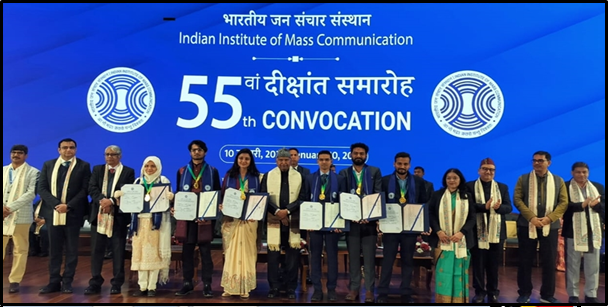Deepfakes, Paid and Fake News
@AIR PICS
News
- Former President Ram Nath Kovind has voiced concerns about deepfake, paid news, and fake news, stating that people need to be prepared to face the difficulties brought on by the development of new technologies.
- Speaking at the Indian Institute of Mass Communication’s (IIMC) 55th convocation ceremony in New Delhi, Mr. Kovind stated that it is important to investigate the problem of false information’s negative effects on society.
- He asserted that it is the emerging journalist’s duty to present reliable information in this situation and he also mentioned the sensationalism that the media produces in order to get high viewership, emphasizing how difficult it is to uphold journalism’s ideals.
| Deepfake
● Deepfakes are artificial intelligence (AI)-generated or altered visual and audio files, typically with the goal of tricking or misleading someone. ● A method known as generative adversarial networks (GANs) uses a generator and a discriminator, two competing neural networks, to produce deepfakes. ● While the discriminator attempts to discern between real and fake images and videos, the generator attempts to produce fakes that appear realistic. ● The generator adjusts its output based on the discriminator’s feedback until it fools the discriminator. ● Tools to tackle deepfake: ○ The summit’s “Blatchley Declaration” recognized the dangers of purposeful abuse and the loss of control over artificial intelligence (AI) technologies. ○ A worldwide framework for the development of “ethical” AI tools has been demanded by India. ○ Existing laws, such as Sections 67 and 67A of the Information Technology Act (2000), contain provisions that may apply to certain aspects of deep fakes, such as defamation and the publication of explicit content. ○ Section 500 of the Indian Penal Code (1860) punishes defamation. ○ The Digital Personal Data Protection Act offers some protection against the misuse of personal information. ○ According to the Information Technology Rules, 2021, content that impersonates other people and images that have been artificially morphed must be removed within 36 hours. Paid News ● Paid news is any news or analysis that appears in print or electronic media in exchange for payment in kind or cash, according to the Press Council of India (PCI). ● Examples: Advertisements disguised as news, denial of coverage to specific electoral candidates, the exchange of advertisement space for equity stakes between media companies and corporations, and the rise in paid content as examples of paid news. IIMC ● IIMC is one of India’s leading educational institutions for media and communication. Founded in 1965, IIMC provides postgraduate diploma programs in journalism in the following areas: digital media, radio and television, advertising and public relations in multiple languages. ● It comes under the ‘Ministry of information and broadcasting.’ |
Source: newsonair
Disclaimer: All efforts have been made to represent India accurately and as per India government. However, Universal School of Administration, Bengaluru and its associated people do not own any responsibility for the correctness or authenticity of the same.
Please notify on the email: [email protected] if any inconsistency is found for the factual correctness.

 @AIR PICS
@AIR PICS

